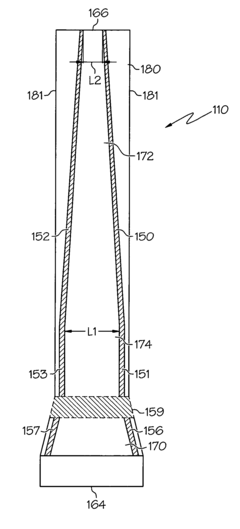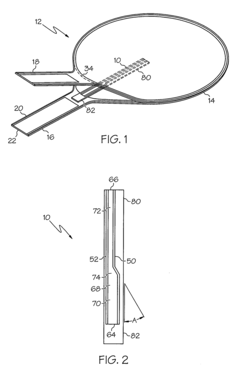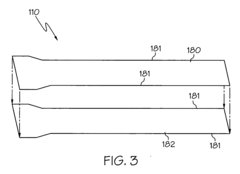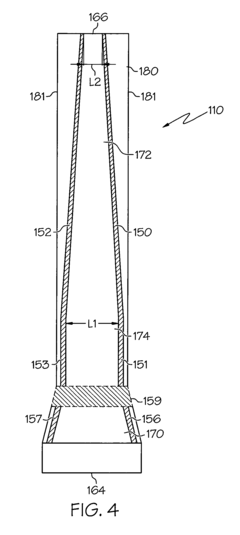Preventing Leakage In Check Valves: A Technical Guide
NOV 7, 20243 MIN READ
Generate Your Research Report Instantly with AI Agent
Patsnap Eureka helps you evaluate technical feasibility & market potential.
Check Valve Technology Background And Goals
The primary objective is to provide a comprehensive overview of the technological landscape surrounding check valve leakage prevention. This includes tracing the historical evolution of relevant technologies, identifying key milestones and breakthroughs, and projecting future development trajectories.
Particular emphasis will be placed on delineating the critical technological challenges and bottlenecks that currently impede progress in this domain. By dissecting the root causes and underlying factors behind check valve leakage, potential avenues for innovation and disruptive solutions can be explored. The ultimate goal is to furnish insights that inform strategic decision-making and guide long-term research and development efforts.
Particular emphasis will be placed on delineating the critical technological challenges and bottlenecks that currently impede progress in this domain. By dissecting the root causes and underlying factors behind check valve leakage, potential avenues for innovation and disruptive solutions can be explored. The ultimate goal is to furnish insights that inform strategic decision-making and guide long-term research and development efforts.
Check Valve Market Demand Analysis
- Market Size and Growth
The global check valve market is expected to witness significant growth, driven by increasing demand from industries like oil and gas, chemical processing, and water treatment. The market size is projected to reach billions of dollars by the end of the forecast period. - Industry Trends
Key trends shaping the check valve market include the rising adoption of advanced materials for improved durability and corrosion resistance, the demand for compact and lightweight designs, and the integration of smart monitoring technologies for predictive maintenance. - Regional Dynamics
Asia Pacific is anticipated to be the fastest-growing region due to rapid industrialization and infrastructure development. North America and Europe are mature markets, while the Middle East and Africa show promising growth potential due to investments in the oil and gas sector. - Application Segments
The oil and gas industry is a major consumer of check valves, followed by the chemical and petrochemical sectors. Water and wastewater treatment, power generation, and pharmaceutical industries are also significant application areas.
Check Valve Technology Status And Challenges
- Valve Leakage Issues
Check valves are prone to leakage due to wear, corrosion, and improper sealing, leading to fluid loss, contamination, and safety hazards. - Causes and Mechanisms
Common causes include valve seat degradation, debris accumulation, thermal cycling effects, and inadequate sealing force or design flaws. - Industry Challenges
Harsh operating environments, stringent regulations, and the need for reliable, low-maintenance valves pose significant challenges for various industries. - Geographic Distribution
Leakage issues are prevalent across industries worldwide, with higher concentrations in regions with aging infrastructure or extreme conditions.
Check Valve Current Technical Solutions
01 Sealing Mechanism
The check valve structure incorporates sealing elements like O-rings, gaskets, or specialized sealing surfaces to create a tight seal between valve components, preventing fluid leakage when closed.- Sealing Mechanism: The check valve structure incorporates sealing elements like O-rings, gaskets, or specialized sealing surfaces to create a tight seal between valve components, preventing fluid leakage when closed.
- Anti-Backflow Design: The check valve design includes specialized valve seat geometries, spring-loaded mechanisms, or other components to ensure a tight seal and prevent fluid backflow when closed.
- Pressure-Responsive Sealing: The check valve incorporates pressure-activated seals, deformable sealing elements, or other components that respond to pressure changes to enhance sealing capability and prevent leakage under high fluid pressures.
- Self-Cleaning or Debris-Resistant Design: The check valve design incorporates self-cleaning mechanisms, filters, or specialized valve geometries to minimize debris buildup and ensure proper sealing, preventing clogging and leakage.
- Redundant Sealing Mechanisms: The check valve incorporates multiple sealing elements, backup seals, or a combination of different sealing technologies to provide additional protection against leakage and ensure reliable, leak-proof operation.
02 Anti-Backflow Design
The check valve design includes specialized valve seats, spring-loaded mechanisms, or other components to ensure a tight seal in the closed position, preventing fluid backflow through the valve.Expand Specific Solutions03 Pressure-Responsive Sealing
The check valve design incorporates pressure-activated seals, deformable sealing surfaces, or other components that respond to pressure changes to create a tighter seal and prevent leakage under high-pressure conditions.Expand Specific Solutions04 Self-Cleaning or Debris-Resistant Design
The check valve design incorporates self-cleaning mechanisms, debris-resistant valve seats, or other components to prevent debris or buildup that could compromise the valve's sealing ability and cause leakage.Expand Specific Solutions05 Redundant Sealing Mechanisms
The check valve design incorporates multiple sealing mechanisms or redundant seals, such as a combination of O-rings and gaskets or multiple sealing surfaces, to provide additional protection against leakage and create a more robust sealing system.Expand Specific Solutions
Check Valve Main Player Analysis
The competitive landscape for preventing leakage in check valves is characterized by established and emerging companies. The industry is mature, driven by the need for reliable fluid control across sectors. Major players like Miura Co., Ltd., Fisher Controls International LLC, ABB Group, Robert Bosch GmbH, and General Electric Company offer advanced solutions with extensive market presence. Emerging companies like Zhejiang Dunan Intelligent Control Technology Co., Ltd. and Nantong Lipei Fluid Valves Industry Co., Ltd. contribute to innovation, indicating a dynamic and competitive market.
Fisher Controls International LLC
Technical Solution: Fisher Controls International LLC offers advanced check valve solutions designed to prevent leakage, focusing on precision engineering and high-quality materials for reliable performance in various industrial applications.
Strength: High reliability and precision engineering. Weakness: Higher cost compared to standard solutions.
Cameron International Corp.
Technical Solution: Cameron International Corp. specializes in high-performance check valves with innovative designs and materials for superior sealing capabilities, ensuring reliable operation and minimal leakage under extreme conditions.
Strength: Superior sealing capabilities and durability. Weakness: Limited availability in some regions.
Check Valve Key Technology Interpretation
Check-valve for reduction of leakage caused by valve flapping
PatentActiveUS20060201549A1
Innovation
- The shape of the heat seals is designed to focus the flow of gas in the valve, reducing flapping and leakage caused by using elongated parallel heat seals.
- The valve design allows for tying of balloons while reducing the risk of leakage.
- The valve enables faster inflation of balloons without leakage, reducing labor costs and faulty product returns.
Check Valve Leakage Prevention Economic Analysis
Check valve leakage can lead to significant economic losses in various industries. A comprehensive economic analysis is crucial to assess the potential impact and justify investments in leakage prevention solutions. Key factors to consider include the cost of lost product or material, environmental cleanup expenses, regulatory fines, and production downtime. Additionally, the analysis should evaluate the costs of implementing prevention measures, such as valve replacement, maintenance programs, or advanced monitoring systems. By quantifying these costs and comparing them to the potential savings from reduced leakage, businesses can make informed decisions about the most cost-effective strategies for preventing check valve leakage and minimizing economic losses.
Check Valve Leakage Prevention Policy And Regulatory Impact
Check valve leakage is a critical issue that can lead to significant economic and environmental consequences. Regulatory bodies have implemented stringent policies to mitigate leakage risks. These policies mandate regular inspections, maintenance, and replacement of faulty valves. Additionally, they outline strict guidelines for valve design, material selection, and installation procedures to enhance leak prevention. Failure to comply with these regulations can result in hefty fines and legal penalties. The regulatory framework aims to promote best practices and foster a culture of safety and environmental responsibility within the industry.
Unlock deeper insights with Patsnap Eureka Quick Research — get a full tech report to explore trends and direct your research. Try now!
Generate Your Research Report Instantly with AI Agent
Supercharge your innovation with Patsnap Eureka AI Agent Platform!



